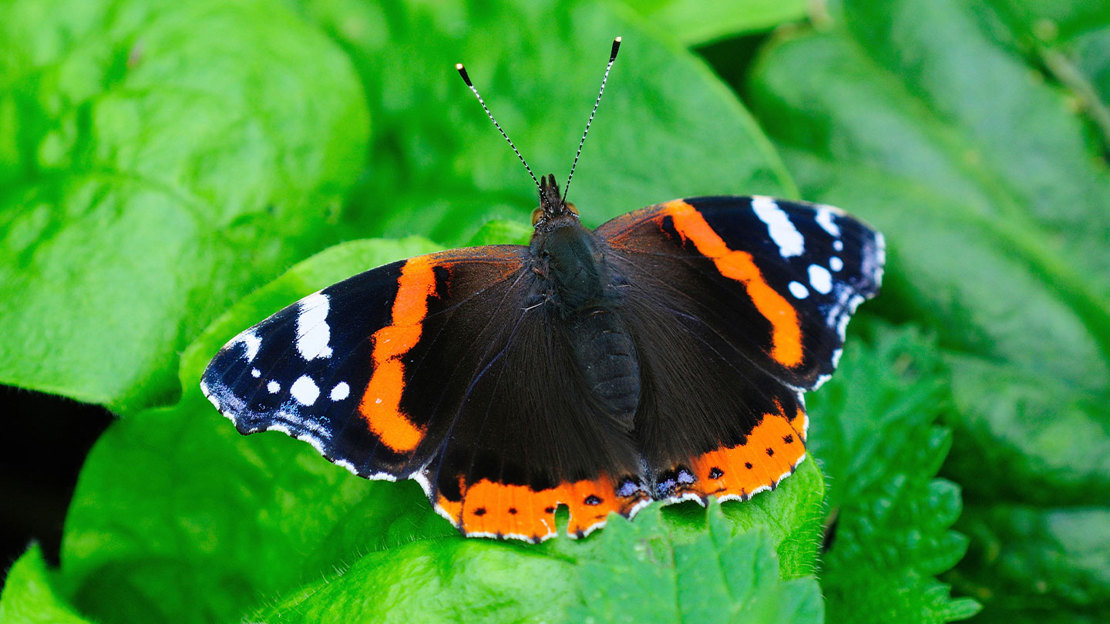Common name: red admiral
Scientific name: Vanessa atalanta
Family: Nymphalidae
Habitat: gardens, woodland, open countryside
Caterpillar food plant: common (stinging) nettle
Predators: birds
Origin: native

Content manager
They're big, beautiful and an almost guaranteed sight in any British garden this summer. But can you confidently identify all the life stages of the red admiral butterfly, and do you know where to look for them?
Common name: red admiral
Scientific name: Vanessa atalanta
Family: Nymphalidae
Habitat: gardens, woodland, open countryside
Caterpillar food plant: common (stinging) nettle
Predators: birds
Origin: native

A large, robust butterfly and strong flier. The wings are mostly velvety black with orange-red bars on the the forewings and blocks of white towards the tips. The fringes of the hindwings are also orange-red and contain small blue eye spots nearest the body.
Females are slightly larger than males and can measure up to 78mm from wing tip to wing tip.
Adults feed during the day, feeding on the nectar of flowers such as ivy, buddleia and other garden plants. Towards the end of summer and into autumn, fallen and rotting fruit also provides an important source of sugar.
Red admirals are common and widespread across the UK and are thought to have increased in number in recent years.
They are a regular garden visitor - look for them feeding on flowers or basking in sunny spots. They can also be found attempting to overwinter in houses, log piles, garden sheds and other sheltered places.
The adult butterflies are on the wing from spring until as late as November. Migrants arrive from continental Europe and North Africa as early as March, and the eggs they lay produce a fresh emergence of adults in late summer.
Most adults begin to migrate south again by the end of the summer, but some are thought to successfully hibernate here through the winter.

Tiny and green with fine, vertical ridges. Each egg is around the size of a pin head.
Eggs are laid singly on the edges of young nettle leaves.
Eggs are usually laid between April and September.

Black and spiny with fine hairs along the body and a pale yellow stripe on either side.
Mostly common (stinging) nettle but sometimes also hop, small nettle and pellitory-of-the-wall.
Red admiral caterpillars can be hard to spot. Look among patches of nettles for the protective tent each caterpillar makes. They use a special kind of silk to bind nettle leaves together.
Caterpillars are most active between May and September.

Dull brown and leaf-like with a ridge of peaks along the underside.
Look for them attached to the underside of nettle leaves, usually with a protective leaf tent around them.
Look for red admiral pupae between August and October.
The Nature’s Calendar project tracks the effects of weather and climate change on wildlife across the UK – its records date all the way back to 1736! Butterflies are among 69 wildlife species recorded for the project.
Join Nature’s Calendar to record your sightings - every record is crucial and valid. The data recorded helps us to better understand the effects of climate change and other patterns in the natural environment. By taking just a few minutes to share what you see, you'll be adding to hundreds of years' worth of important data.
Let us know what you've seen and where, and you could help us track the effects of climate change on our wildlife.
Record your sighting